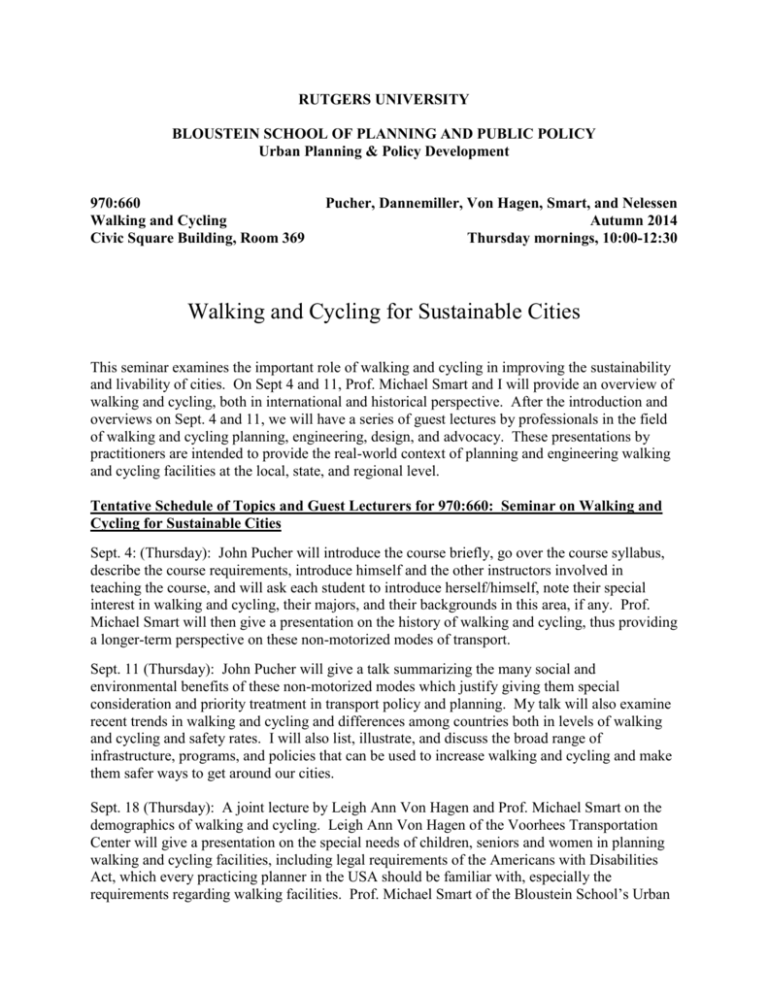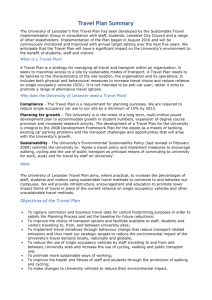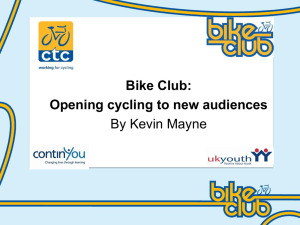660-FA14-Pucher-20140825-170358
advertisement

RUTGERS UNIVERSITY BLOUSTEIN SCHOOL OF PLANNING AND PUBLIC POLICY Urban Planning & Policy Development 970:660 Walking and Cycling Civic Square Building, Room 369 Pucher, Dannemiller, Von Hagen, Smart, and Nelessen Autumn 2014 Thursday mornings, 10:00-12:30 Walking and Cycling for Sustainable Cities This seminar examines the important role of walking and cycling in improving the sustainability and livability of cities. On Sept 4 and 11, Prof. Michael Smart and I will provide an overview of walking and cycling, both in international and historical perspective. After the introduction and overviews on Sept. 4 and 11, we will have a series of guest lectures by professionals in the field of walking and cycling planning, engineering, design, and advocacy. These presentations by practitioners are intended to provide the real-world context of planning and engineering walking and cycling facilities at the local, state, and regional level. Tentative Schedule of Topics and Guest Lecturers for 970:660: Seminar on Walking and Cycling for Sustainable Cities Sept. 4: (Thursday): John Pucher will introduce the course briefly, go over the course syllabus, describe the course requirements, introduce himself and the other instructors involved in teaching the course, and will ask each student to introduce herself/himself, note their special interest in walking and cycling, their majors, and their backgrounds in this area, if any. Prof. Michael Smart will then give a presentation on the history of walking and cycling, thus providing a longer-term perspective on these non-motorized modes of transport. Sept. 11 (Thursday): John Pucher will give a talk summarizing the many social and environmental benefits of these non-motorized modes which justify giving them special consideration and priority treatment in transport policy and planning. My talk will also examine recent trends in walking and cycling and differences among countries both in levels of walking and cycling and safety rates. I will also list, illustrate, and discuss the broad range of infrastructure, programs, and policies that can be used to increase walking and cycling and make them safer ways to get around our cities. Sept. 18 (Thursday): A joint lecture by Leigh Ann Von Hagen and Prof. Michael Smart on the demographics of walking and cycling. Leigh Ann Von Hagen of the Voorhees Transportation Center will give a presentation on the special needs of children, seniors and women in planning walking and cycling facilities, including legal requirements of the Americans with Disabilities Act, which every practicing planner in the USA should be familiar with, especially the requirements regarding walking facilities. Prof. Michael Smart of the Bloustein School’s Urban 2 Planning Program will discuss the particular importance of walking and cycling to low-income households and minorities, not simply for getting to jobs but also in daily life, reaching all the many shopping, educational, medical, and recreational destinations they need to access. It is crucial to take the needs of all these groups into account in designing walking and cycling facilities. As it turns out, the safety of walking and cycling also affects groups differently. For example, low-income households, children, and seniors tend to have especially high levels of walking and cycling injury rates, so there is an important distributional/equity impact of the currently dangerous conditions for walking and cycling, not only in the USA but also in the cities of virtually all developing countries. We only have a week for this broad-ranging and important topic, and one could spend an entire semester on the topic, but Leigh Ann Von Hagen and Prof. Michael Smart will give us a good overview of the main issues. Sept 25 (Thursday): Bonnie Petrauskus (Johnson & Johnson), Jean Holtz (New Brunswick Development Corporatoin), Jaymie Santiago (New Brunswick Tomorrow), Glenn Paterson (City of New Brunswick), Karen Jenkins (BikeWalkNJ), Mariam Merced (Robert Wood Johnson University Hospital) and Charles Brown (Voorhees Transportation Center) will discuss Ciclovias. Each and every one of these individuals was crucial in making the NB CicloVIA possible and coordinating the efforts of so many different organizations with different perspectives. Ciclovias are open-street events (also called Sunday Parkways, Summer Streets, and locally specific names like CiLAvia in Los Angeles; Siclovia in San Antonio, TX; and Somerstreets in Somerville, MA) where streets are closed to motor vehicles and opened up to pedestrians, bicyclists, skateboarders, in-line skaters, and various other forms of non-motorized transportation as a way to increase physical activity, integrate different parts of the community, promote more walking and cycling on a regular basis, and provide a fun event for everyone to enjoy. There are over a hundred such open streets events in North American cities, with the number increasing rapidly every year. The focus of the presentation will be the CicloVIA here in New Brunswick, which was first held in October 2013, but was held for a second time in May 2014 and a third time in July 2014. The timing of this presentation is perfect because the fourth NB CicloVIA will be held on Sunday, October 12, 2014. I am asking all students taking this course to take part in the Oct. 12 Ciclovia and to submit a one-page report on your experiences of the CicloVIA here in NB, due on Oct. 16, the Thursday immediately following the Oct. 12 CicloVIA. Oct. 2 (Thursday): Lois Goldman, Pam Fischer, and Elizabeth Thompson (of the North Jersey Transportation Planning Authority) will give presentations on the crucial role of metropolitan planning organizations (MPOs) and regional planning in ped/bike planning, funding, and policy coordination among localities. This is a very important presentation, not only due to the information about ped/bike planning by MPOs, but also about what MPOs do and whether you might be interested in working for an MPO. Although MPO names vary from city to city, they are, by far, the most important transportation planning organization for any metropolitan area. We are very lucky indeed to have three superb representatives of our local MPO (North Jersey) speak to us on the issue of ped/bike planning. Oct. 9 and 16 (Thursdays): Mike Dannemiller (professional engineer with The RBA Group, an engineering and planning consulting firm) will be giving two weeks of presentations on the very important nitty-gritty, nuts-and-bolts of ped/bike facility design and engineering. These are some of the specific tools many students have asked for in past years, and Mike is truly a 2 3 brilliant ped/bike engineer. His lectures have been a hit with the students each of the past three years this course has been offered. Mike Dannemiller is asking all students in the class to be familiar with two very important sets of resources concerning the design and engineering of bicycling and walking facilities. You will find them on the main website of, the National Organization of City Transportation Officials: nacto.org. NACTO Urban Bikeway Design Guide: http://nacto.org/cities-for-cycling/design-guide/ NACTO Urban Street Design Guide: http://nacto.org/usdg/ Oct. 12 (Sunday): CicloVIA in New Brunswick. All students are required to participate in some way and to write up a one page report describing your experience, your evaluation, your suggestions for improvement, ideas for expanding it or changing routes, etc. The report is due on Thursday, Oct. 16, the Thursday following the NB CicloVIA. Oct. 23 (Thursday): Kimberly Craft (the brilliant city engineer for Montclair) and Laura Torchio (superb professional planner and fervent bike/walk advocate) will give presentations on ped/bike planning in Montclair, a city which has been at the vanguard of ped/bike policies in NJ. Kim and Laura have worked in tandem in Montclair for several years and have produced some truly great improvements in walking and cycling conditions there. Their talk has been a huge success for each of the past three years, and I am sure they will knock our socks off this year as well. Do not miss this special event!!! Kim and Laura are a truly dynamic duo, and they provide exemplary models of planning and engineering professionals you can emulate. Oct. 30 (Thursday): Rich Conroy of Bike New York will provide an overview of cycling developments in NYC, and in particular the role of Bike New York in encouraging cycling through its various educational and promotional programs (like the 5-Borough Bike Tour every year). Bike New York is a not-for-profit organization whose mission is to facilitate and promote cycling in all five boroughs of New York City through education and public events as well as collaboration with both community organizations and municipal agencies. Rich Conroy has been the director of education at Bike New York since 2004. He is an avid touring and commuter cyclist, and a League Cycling Instructor as well as an instructor trainer for the League of American Bicyclists. Oct. 31 (Friday, Halloween): This is just a tentative idea, but we might consider an all-day field trip to NYC to see some of the things Rich Conroy told us about the previous day. But we would restrict ourselves to Manhattan, within easy walking and/or bicycling distance from Penn Station, where we would be arriving. If too many students cannot make this field trip for whatever reasons, or if the weather is bad, we will cancel it altogether. It is just an idea, a proposal on my part, and unless get can get at least 90% student participation, we will not have a field trip at all. I will need to know soon after our first class whether or not you are certain you can or cannot participate in the field trip. I also need to know whether or not you are able and willing to ride a Citi Bike in NYC, just in case the folks from Citi Bike can loan us some bikes. It’s unlikely, but at least I did ask them about this. Nov. 6 (Thursday): This is our Philadelphia Day! We have the enormous good fortunate of having Charles Carmalt (head of ped/bike planning for the City of Philadelphia) and John Boyle (research director of the Philadelphia Bicycling Coalition) speak to us on developments in 3 4 walking and bicycling in Philadelphia, and in particular, what policies and infrastructure improvements have been implemented in Philadelphia to increase walking and cycling and make them safer ways to get around the city on a daily basis. Nov. 13 (Thursday): Glenn Paterson (transportation planner for New Brunswick) and Frank Wong (transportation planner for Rutgers) will give presentations on ped/bike planning in New Brunswick and Rutgers University. Every student in this seminar experiences the walking and cycling situation here in New Brunswick on a daily basis, so all students should be especially active in your participation. Maybe you have some ideas you’d like Glenn and Frank to consider for improving walking and cycling here where we live, work, study, and have to get around every day. Nov. 20 (Thursday): Guest presentation on bike sharing by Dr. Nick Klein, who is a postdoctoral fellow at the Voorhees Transportation Center of the Bloustein School. Nick taught an entire course (studio/workshop) on the topic of bike sharing a few years ago at the Bloustein School, and he will be updating that material to present you with the very latest, up to date information on bike sharing trends and technologies throughout the world. Bike sharing is one of the most dramatic developments in bicycling in the USA if not the world. We will examine it critically and discuss its advantages and disadvantages. Nov. 25 (Tuesday): Rutgers moves Thursday classes to Tuesday during Thanksgiving week, so our class meets on Tuesday that week and not Thursday, as usual. On this Tuesday before Thanksgiving, Prof. Tony Nelessen will give the culminating lecture in the class on the crucial topic of urban design and how the very layout and design of cities affects walking and cycling. He will provide examples of good urban design that facilitates walking and cycling by making them feasible, safe, and interesting ways to get around. There are many readings posted on the Sakai website relating to the specific issue of how to design cities to encourage more walking and cycling, and I will ask students to read those articles before Prof. Nelessen’s lecture (especially the readings by Kevin Krizek, Ann Forsyth, and Anne Vernez Moudon, all of whom are urban designers). Nov. 27 (Thursday): Thanksgiving Day. No class. Dec. 4 and 11 (Thursdays): Final student presentations on specific topics (e.g. bikesharing in some specific city (or cities), cycle tracks in some specific city (or cities), bike boulevards, safe routes to schools, ciclovias, Critical Mass, bike helmets, bike boxes, bike technology, sidewalk design at intersections, crossing signals, pavement markings, bike parking vs. car parking, bike corrals, etc.) OR on specific corridors, streets, plazas, intersections (perhaps identifying current problems and suggesting specific redesigns that would improve walking and biking conditions). Some examples of recent projects: a redesign of Livingston Avenue in New Brunswick that would make it into a complete street; this could be done for virtually any street in any city in the world, so there are a lot of potential such re-designs of streets for you to consider turning George Street into a ped/bike/transit mall, off limits to cars; again, this could be examined for streets in cities all over the US and elsewhere in the world 4 5 current problems and redesigns of sites such as the intersections of Albany Street and Easton Avenue; Albany Street and George Street; River Road, Raritan Avenue, and the Albany Street Bridge in Highland Park; several intersections on French Street in New Brunswick beyond the hospital (headed south toward Princeton); again, this could be done in other cities as well redesign of the area around the NB train station to make it safer, more convenient, and more pleasant for pedestrians and cyclists to access it; again this could be done in other cities as well How NJ Transit or PATH or the NYC subway system could improve bike-transit integration, perhaps based on the far superior bike-transit integration one finds in Europe and in other US and Canadian cities on-site observation of current problems of Louis Armstrong Plaza (125th Street and 5th Avenue in NYC) and suggestions for alternative improved designs; this could be done for virtually ANY major intersection in ANY city where there is a lot of pedestrian traffic and the intersection needs to be redesigned to make it safer and more convenient for pedestrians analysis of the car-free section of Broadway in Manhattan; again, this could be done for ANY city which have turned certain streets or zones into car-free areas, either here in the USA or elsewhere in the world the High Line in NYC, and comparisons to similar projects in Paris, Chicago, and elsewhere analysis of the Prospect Park cycle track in Brooklyn, or of ANY cycle track (protected bike lane) anywhere in the world, either the US or Canada or Australia or Europe or anywhere! description and analysis of the East Coast Greenway and similar greenway projects elsewhere, even if on a smaller scale But there are literally hundreds if not thousands of possibilities, and you might want to examine something specific to a town you are especially familiar with or interested in. It’s really up to you, but please discuss the topic with me in advance so I can be sure it’s feasible. I’ll need to know about 3 or 4 weeks into the semester what you are planning to do for the final project, and which week you would like to present. Students will be required to hand in printouts of the PPT slides from their presentations before the presentations so that I can make comments and provide feedback on the presentations while you are making them. Students can make presentations either individually or in teams of two. The amount of time allowed for the presentations will depend on the number of students taking the course, since all presentations will have to fit into the two-week time frame for final presentations. There are three basic goals of the course: 1) to provide students with a good overview of walking and cycling trends, issues, and policies in international comparative perspective; 2) to provide students with the practical information and tools to plan walking and cycling facilities and to design streets, neighborhoods, and cities that encourage walking and cycling in a safe, sustainable environment; and 3) to share with students the real-life, practical experience of planning and engineering professionals of how to implement projects, the obstacles that have to be overcome, political considerations, citizen inputs, and generating the public support needed to improve walking and cycling conditions. 5 6 Course requirements: There are two main course requirements: 1) attendance at all class sessions, and active participation in class discussions; 2) a PPT presentation at the end of the semester on a very specific topic. The final presentations will be on Dec. 4 and 11. There is no final paper required, but students are required to turn in printouts of their PPT slides (no more than two slides per page) prior to their presentation. In addition, I am asking all students to participate in the Sunday, Oct. 12 CicloVIA in New Brunswick and to turn in a one-page evaluation of the event by the following Thursday, Oct. 16. Course attendance and active class participation are required of all students. Students are required to attend all classes during the semester, including those where other students are making presentations. According to new university regulations, students missing a class for any reason are required to notify the instructor in advance and to report the date and specific reason for their absence on the new university attendance website: https://sims.rutgers.edu/ssra/ . The Rutgers reporting system then automatically sends an email to me. Rutgers University now requires us to include this absence reporting requirement on all course syllabi. Important: Use of laptop computers, cell phones, iPads, iPhones, Blackberrys, and other electronic communications devices in the classroom will NOT be permitted unless you have a disability that specifically requires use of such devices for taking notes or hearing the lecture. In the past, I have found that many students are distracted (and rudely distracting) to both other students and the lecturer by text messaging, emailing, websurfing, etc. during class. This will not be permitted in the classroom. If you have a disability that requires such electronic equipment, I need a written note from the Dean’s Office authorizing this. Otherwise, use of such devices during class will not be permitted. I am sorry to have such a strict policy on this, but my lenience in the past has led to truly outrageous abuse by some students, and it simply will not be permitted this year. I find it especially rude to the guest lecturers and to your fellow students when they are making presentations, and instead of giving them your full attention, some students are busy text messaging, reading emails, or websurfing. Please turn off all such devices at the beginning of class. Thanks so very much for your understanding and cooperation. The approximate distribution of assignments toward the final course grade is: 1) CicloVIA participation and report: 10% 2) final project report and oral presentation: 60% 3) class participation: 30% 6 7 The exact percentage distribution of points toward the overall course grade is subject to change, as will be announced during the semester, when the number and nature of assignments is finally determined. Due dates for each assignment will be announced as the semester progresses. Students are expected to turn in assignments on time, and to ensure fairness among students, late penalties will be assessed in proportion to the degree of lateness. Academic integrity Academic honesty and intellectual integrity are fundamental to the process of learning and to evaluating academic performance. This is the responsibility of all members of the university, and students share the responsibility for creating and maintaining an atmosphere of honesty and integrity. If you have any doubt about what constitutes academic integrity, consult http://teachx.rutgers.edu/integrity/policy.html. Syllabi and readings for ped/bike courses at other universities: The corresponding ped/bike planning course syllabi for UC Berkeley, UC Davis, UNC Chapel Hill, UCLA, Portland State, Univ of Oregon, University of Wisconsin, and the FHWA ped/bike course are all posted in the Resources section of the Sakai website. See especially the three Word files for UC Berkeley, which contain an extensive listing of many useful resources, often with URL weblinks. I have not tried to include everything from these other university ped/bike course syllabi on the syllabus and Sakai website for our Rutgers ped/bike seminar, but I have posted all of those other university ped/bike syllabi and their related listings of resources onto our Sakai website for your easy access and reference. Course Readings and Bibliography: I. History, background, international overview of walking and cycling (2 weeks) Buehler and Pucher, “International Overview: Cycling Trends in Western Europe, North America, and Australia,” City Cycling, MIT Press, 2012, pp. 9-30. Pucher, Buehler, and Seinen, “Bicycling Renaissance in North America? An Update and ReAssessment of Cycling Trends and Policies,” Transportation Research A, Vol. 45, No. 6, pp. 451-474. <http://policy.rutgers.edu/faculty/pucher/TRA960_01April2011.pdf> Alliance for Biking and Walking, Bicycling and Walking in the United States: 2014 Benchmarking Report. Funded by the Centers for Disease Control and Prevention, the American Association of Retired People, and the American Public Transportation Association. http://www.bikewalkalliance.org/download-the-2014-benchmarking-report Pucher, Buehler, Merom, and Bauman, "Walking and Cycling in the United States, 2001-2009: Evidence from the National Household Travel Surveys," American Journal of Public Health, Vol. 101, Published online ahead of print May 5, 2011: e1–e8. doi:10.2105/AJPH.2010.300067. 7 8 <http://policy.rutgers.edu/faculty/pucher/2001-2009.pdf> John Pucher and Ralph Buehler, "Making Cycling Irresistible: Lessons from the Netherlands, Denmark, and Germany," Transport Reviews, Vol. 28, No. 4, July 2008, pp.495-528. <http://policy.rutgers.edu/faculty/pucher/Irresistible.pdf> John Pucher, Jennifer Dill, and Susan Handy, “Infrastructure, Programs, and Policies to Increase Bicycling,” Preventive Medicine, Vol. 50, No. S1, January 2010, pp. S106-S125.” Accessible at: <http://policy.rutgers.edu/faculty/pucher/Pucher_Dill_Handy10.pdf> II. Funding and implementation of walking and cycling infrastructure and programs Note: The new federal transportation legislation MAP-21, which was just passed in summer 2012, changed many aspects of federal transport funding, especially for pedestrian and bicycling projects. Here is the official USDOT summary of that legislation: US Department of Transportation, “MAP-21: Moving Ahead for Progress in the 21st Century,” Summary of the new Federal transportation law, in effect on Oct. 1, 2012 and for two years. <http://www.fhwa.dot.gov/map21/summaryinfo.cfm> And for a brief summary of the changes in this new MAP-21 federal legislation compared to previous legislation (SAFETEA-LU), and especially implications for ped/bike funding, see: Streetsblog DC, “MAP-21 Puts the Squeeze on Bridge Repairs and Bikes,” http://dc.streetsblog.org/2012/07/25/map-21-puts-the-squeeze-on-bridge-repair-and-bikes/#more283925 McCann and Handy, “Regional Response to Federal Funding for Bicycle and Pedestrian Projects,” Journal of the American Planning Association, Vol. 77, No. 1, winter 2011, pp. 2338. PDF posted on Sakai in Implementation/Funding resource folder. Pucher et al. “Bicycling Renaissance,” see pp. 456-457. <http://www.ecf.com/files/2/12/22/PucherBuehlerSeinen_BikeRenaissance_TRA2011.pdf> FHWA ped/bike course, pp. 7-10 USDOT, FHWA, “Bicycle and Pedestrian Provisions of the Federal-aid Program” <http://www.fhwa.dot.gov/environment/bikeped/bp-broch.htm> USDOT, FHWA, “Pedestrian & Bicycle Program Activities -January 2011,” <http://www.fhwa.dot.gov/environment/bikeped/trb2011.htm> USDOT, FHWA, “FHWA and FTA Funds that may be used for bicycle and pedestrian <activities,” http://www.fhwa.dot.gov/hep/bkepedtble.htm> 8 9 III. Health benefits and safety of walking and cycling (mentioned briefly on Sept 12 during overview PPT but not examined in detail; the first two publications listed below, chapters in City Cycling, provide a good summary of all the information you need to know) Garrard, Bauman, and Rissel, “Health Benefits of Cycling,” in City Cycling, MIT Press, 2012, pp. 31-56. Jacobsen and Rutter, “Cycling Safety,” in City Cycling, MIT Press, 2012, pp. 141-156. “3 Way Street,” 3-minute video of very dangerous intersection in Manhattan, with many ped/bike/car conflicts. <http://vimeo.com/24572222> US Department of Transportation, “Pedestrian and Bicyclist Safety” in FHWA University Course on Pedestrian and Bicycle Transportation, Washington, DC, July 2006. Lesson 3, pp. 31-50. <http://www.fhwa.dot.gov/publications/research/safety/pedbike/05085/pdf/combinedlo.pdf> Transportation for America, Dangerous by Design 2011: Solving the Epidemic of Preventable Pedestrian Deaths, excellent overview of pedestrian dangers in USA, especially arising from roadway design and lack of planning for pedestrians. PDF of full report posted on Sakai. U.S. Department of Transportation. How to Develop a Pedestrian Safety Action Plan, March 2009. Available online: http://safety.fhwa.dot.gov/ped_bike/docs/fhwasa0512.pdf. (skim document) IV. Complete Streets, ADA Requirements, and Traffic Calming (covered partly on Sept 26 and Oct. 3 by Mike Dannemiller, but also on Nov. 14 in lecture by Leigh Ann Van Hagen) McCann and Rynne, eds., Complete Streets: Best Policy and Implementation Practices. American Planning Association. <http://www.completestreets.org/webdocs/resources/cs-bestpractices-chapter5.pdf> National Complete Streets Coalition, Introduction to Complete Streets, comprehensive PPT with excellent overview on complete streets. <http://completestreets.org/webdocs/resources/cs-intro.pptx> National Complete Streets Coalition, Complete Streets Policy Analysis 2010: A Story of Growing Strength. <http://www.completestreets.org/webdocs/resources/cs-policyanalysis.pdf> NJDOT, Complete Streets in New Jersey, PPT specifically about complete streets in NJ. PPT posted on Sakai. FHWA ped/bike course: lesson 20 Streetfilms, “Complete Streets: It’s About More Than Bike Lanes” http://www.streetfilms.org/complete-streets-its-about-more-than-just-bike-lanes/ 9 10 V. Planning, Design, and Engineering of Pedestrian Facilities (essential background reading for lectures by Mike Dannemiller on Sept 26 and Oct. 3) NACTO Urban Bikeway Design Guide: http://nacto.org/cities-for-cycling/design-guide/ NACTO Urban Street Design Guide: http://nacto.org/usdg/ FHWA ped/bike course, lessons 8, 9, 10, 11, 12, 19, and 23 Transportation for America, Dangerous by Design 2011: Solving the Epidemic of Preventable Pedestrian Deaths, excellent overview of pedestrian dangers in USA, especially arising from roadway design and lack of planning for pedestrians. PDF of full report posted on Sakai. VI. Planning, Design, and Engineering of Cycling Facilities (essential background reading for lectures by Mike Dannemiller on Sept 26 and Oct. 3) NACTO Urban Bikeway Design Guide: http://nacto.org/cities-for-cycling/design-guide/ NACTO Urban Street Design Guide: http://nacto.org/usdg/ Furth, “Bicycling Infrastructure for Mass Cycling: A Transatlantic Comparison,” in Pucher and Buehler, eds., City Cycling, MIT Press, 2012, pp. 105-140. Parkin and Koorey, “Network Planning and Infrastructure Design,” in Parkin, ed., Cycling and Sustainability, Emerald Press, 2012, pp. 131-160. Posted on Sakai. NACTO Urban Bikeway Design Guide, National Association of City Transportation Officials. <http://nacto.org/cities-for-cycling/design-guide/> FHWA ped/bike course, lessons 13, 14, 15, 16, 17, 19, and 23 Fietsberaad (Dutch Cycling Council), Examples Bank: Best Practice for Cycling Facilities at Intersections, Stretches of Road, and Bike Parking. <http://www.fietsberaad.nl/index.cfm?lang=en&section=Voorbeeldenbank> DuBose, “Physically Separated Bike Lanes: A Game Changer for Mode Split?” ITE Journal. Posted on Sakai. In the listing below are some extremely interesting, informative, really fun videos covering a wide range of topics about cycling infrastructure planning, engineering, and design. Streetfilms, Physically Separated Bike Lanes, video. Posted on Sakai. <http://www.streetfilms.org/physically-separated-bike-lanes/> Streetfilms, The Indianapolis Cultural Trail: The Next-Gen in U.S. Protected Bike Lanes,” video. Posted on Sakai. http://www.streetfilms.org/the-indianapolis-cultural-trail/ 10 11 “Junction Design, the Cycle-Friendly Dutch Way,” superb 2 minute video http://www.youtube.com/watch?v=FlApbxLz6pA “Utrecht Cycling,” superb 12 minute video of bike ride in Dutch city of Utrecht, explaining all the features along the way. <http://www.youtube.com/watch?v=a6Gwn4UnaPM> “Cyclist Left Turns at Main Intersections in the Netherlands,” superb 6 minute video explaining how Dutch handle intersections for cyclists. <http://www.youtube.com/watch?v=67zoLM7l9os> “Junction Design for Safer Cycling in the Netherlands”, superb 3 minute video <http://www.youtube.com/watch?v=rBwMRGxtZ9k> “History of Cycle Paths in the Netherlands,” another superb video <http://www.youtube.com/watch?v=NrqG0DqkSlw> There are even more such videos posted as URL links on the Sakai website, so please be sure to check them out! You will not regret it. VII. Walking and Cycling for Everyone: Special Consideration for Children, Seniors, Women and Persons with Disabilities (covered to some extent by Mike Dannemiller on Oct. 3 as well as by Leigh Ann Van Hagen on Nov. 14) Garrard, Handy, and Dill, “Women and Cycling,” in MIT Press book City Cycling, 2012. Bonham and Wilson, “Women Cycling through the Life Course: An Australian Case Study,” in Parkin, ed., Cycling and Sustainability, 2012, pp. 59-82, posted on Sakai. McDonald, “Children and Cycling,” in City Cycling, MIT Press, 2012. McDonald, Brown, Marchetti, Pedroso, “U.S. School Travel 2009: An Assessment of Trends,” American Journal of Preventive Medicine, Vol. 41, No. 2, August 2011, pp 146-151. PDF posted on Sakai website. US Department of Transportation, “Pedestrian Characteristics: Special Needs of Children, Seniors, Mobility-Impaired/Disabled” in FHWA University Course on Pedestrian and Bicycle Transportation, Washington, DC, July 2006. Lesson 8, pp. 113-127. Posted on Sakai. <http://www.fhwa.dot.gov/publications/research/safety/pedbike/05085/pdf/combinedlo.pdf> [additional readings to be suggested by Leigh Ann Van Hagen] VIII. City Case Studies of Comprehensive, Coordinated Packages of Policies to Promote Walking and Cycling in Europe and North America (resources intended mainly for your reference, especially if you decide to do a city case study presentation as your mid-semester presentation on Oct. 24; but these references below provide truly a wealth of information) 11 12 Fietsberaad (Dutch Bicycling Council), Bicycle Policies in Europe: Continuous and Integral. 2010. Detailed, illustrated, superb city case studies of 12 successful cycling cities in Europe. http://www.fietsberaad.nl/library/repository/bestanden/Fietsberaad_publicatie7_Engels.pdf Pucher and Buehler, “At the Frontiers of Cycling: Policy Innovations in the Netherlands, Denmark, and Germany,” World Transport Policy and Practice, 2007. Detailed, illustrated case studies of cycling in Amsterdam, Copenhagen, Berlin, Groningen, Odense, and Muenster. <http://www.eco-logica.co.uk/pdf/wtpp13.3.pdf> Buehler and Pucher, “Sustainable Transport in Freiburg, Germany,” International Journal of Sustainable Transport, January 2011. Very detailed case study of Germany’s most sustainable city! http://policy.rutgers.edu/faculty/pucher/Freiburg_IJST_BuehlerPucher.pdf John Pucher, Lewis Thorwaldson, Ralph Buehler, and Nick Klein, “Cycling in New York: Innovative Policies at the Urban Frontier," World Transport Policy and Practice, Vol. 16, summer, 2010. http://policy.rutgers.edu/faculty/pucher/CyclingNY.pdf Josh Benson, NYCDOT, “Innovative Bike Facility Design in New York City: Street Design for Bicyclist Safety and Comfort,” PPT talk presented at Toronto conference, 2009. PPT file posted on Sakai. Mike Flynn, “New York City Bike Plan,” PPT on preparation of a bike plan by the director of NYCDOT infrastructure planning. Posted on Sakai as “Bike Master Planning NYCDOT” Philadelphia Bicycling Coalition, Mode Shift: Philadelphia’s Two-Wheeled Revolution in Progress. Report on cycling trends, policies, and bikeways in Philly. Accessible at: http://www.bicyclecoalition.org/files/MODE%20SHIFT%20REPORT.pdf Roger Geller, “Portland Bicycle Plan for 2030: Building on Success,” Oregon ITE Conference, March 2010. Truly SUPERB PPT talk about multi-faceted program in Portland. PDF on Sakai. Roger Geller, “Built it and they will come: Case study of bicycling policies in Portland.” Superb summary of all that Portland has done to promote cycling. PDF posted on Sakai. Streetsfilms on Portland, Oregon: <http://www.streetfilms.org/portland-celebrating-americas-most-livable-city/> Streetsfilms on Copenhagen: http://www.streetfilms.org/copenhagen%E2%80%99s-climate-friendly-bike-friendly-streets/ IX. Urban Design and Land Use to Facilitate Walking and Cycling (please read these articles BEFORE Tony Nelessen’s urban design lecture on Nov. 21) Forsyth and Krizek, “Urban Design: Is there a Distinctive View from the Bicycle?” Journal of Urban Design, January 2011. PDF posted on Sakai. 12 13 Krizek, “Cycling, Urban Form, and Cities: What Do We Know and How Should We Respond?” in Parkin, ed., Cycling and Sustainability, 2012, pp. 111-130. Posted on Sakai. Ann Forsythe and Kevin Krizek, “Promoting Walking and Bicycling: Assessing the Evidence to Assist Planners,” Built Environment, December 2010, Vol. 36, No. 5, pp. 429-446. Posted as a PDF file on Sakai. US Department of Transportation, “Land Use Regulations to Encourage Non-motorized Travel,” “Traditional Neighborhood Design” and “Adapting Suburban Communities for Bicycle and Pedestrian Travel,” in FHWA University Course on Pedestrian and Bicycle Transportation, Washington, DC, July 2006. Lessons 5-7, pp. 75-110. Posted on Sakai. <http://www.fhwa.dot.gov/publications/research/safety/pedbike/05085/pdf/combinedlo.pdf> Transportation Research Board. 2005. Does the Built Environment Influence Physical Activity? Examining the Evidence. Washington D.C. (Please just skim this, as it is a very long.) Accessible at: http://trb.org/news/blurb_detail.asp?id=4536 13




